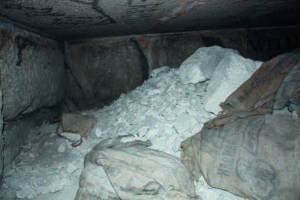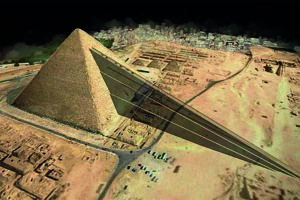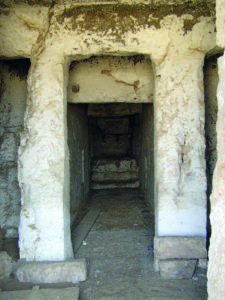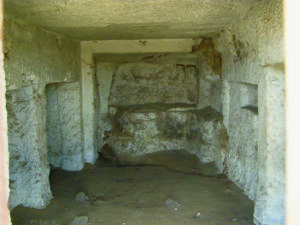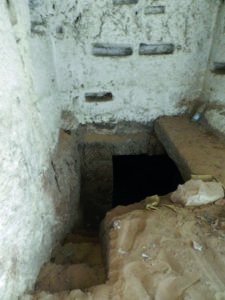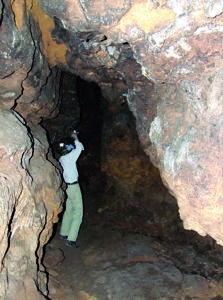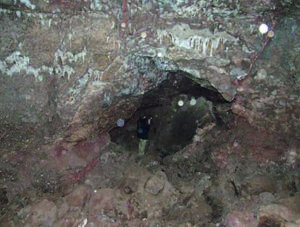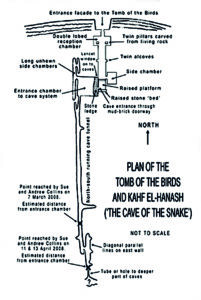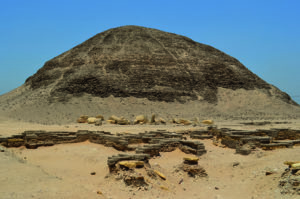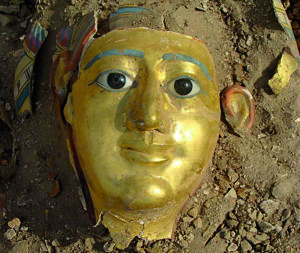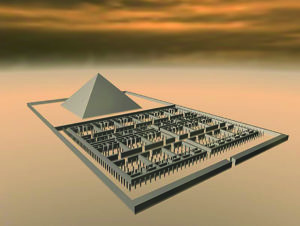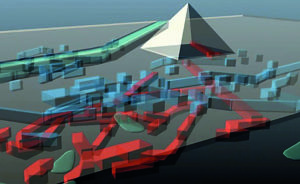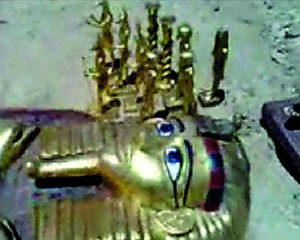Discoveries from 1991 to 2009
1991 – Discovery of subterranean corridors in Cairo
During construction of the Cairo subway, which begun in 1991, in which the engineer Professor Jean Kérisel of France played a consulting role, workers came upon a tunnel-like room that was 5.4 m / 17 ft tall, 3.7 m / 12.1 ft wide and 27 m / 88.6 ft long. The workers were told that this was a natural cavern washed out of the surrounding rock by subterranean water flows. However, eyewitnesses have reported that secret research was conducted at the discovery site. Though the site was declared off-limits to all, several months later a few workers returned to the “cavern“ and saw that the wall had been broken through and that a further room was on the other side. Nowhere was any indication of who might have built the room, similar to all other known megalithic structures in Giza. The disputed Egyptian researcher and author, Erdogan Ercivan, wrote about the discovery the subway building workers found in his book, ”Verbotene Ägyptologie” (Forbidden Egyptology): “Here began a manmade section of branching tunnels stretching a kilometer / 0.6 miles long, the end of which could not be estimated by the workers. The Cairo subway security official, Mohammed Maher Mostafa, also confirmed the existence of the parallel tunnel system, which was there before the subway was built.”
1992 – Scientific exploration of the Sphinx
The detailed description of these discoveries by John Anthony West and Dr. Robert Schoch is already given in Chapter 2 on the age of the Sphinx (see page 62).
1992 – New corridor in the Great Pyramid
In October 1992, Jean Kérisel investigated the Descending Passage in the “Cheops” Pyramid with his remote-sensing equipment. Near the bottom of the corridor, shortly before it leads into the subterranean chamber, the ground-penetrating radar detected a long-shaped structure that could be a passage situated lower down which crosses the horizontal passage at a 45 degree angle and then leads in the direction of the Sphinx.
1993 – 1st exploration of the „Ventilation“ Shafts in the Great Pyramid
The German engineer, Rudolf Gantenbrink, came to Giza through the German Archeological Institute in Cairo, which had been given the job of installing ventilators in the supposed “Ventilation” Shafts in the “King‘s” Chamber. He proposed that the opportunity also be used to more closely inspect the shafts in the “Queen‘s” Chamber, which until then the experts had believed were around 10 m / 32.8 ft long, because the investigations of the Scottish researcher Morton Edgar were ignored in their textbooks. We’ll get right back on that. Gantenbrink‘s first attempt in spring 1992 to inspect the shaft on the southern end of the “Queen‘s” Chamber with his video robot failed after 20 m / 65.6 ft when the shaft grew too steep and narrow for the robot‘s drive mechanism.
After returning to Germany, the engineer built a new robot at his own cost (around USD 250,000), with which he would be able to continue his research. Gantenbrink returned to Cairo on March 6, 1993, accompanied by a professional film team. However, permission for further investigations and the filming that had been granted verbally by Zahi Hawass was called into question on the premise that the Chief Inspector had been (temporarily) relieved from office due to the disappearance of an ancient statue.
The uncertainty drove Gantenbrink to work as quickly and as long as would be allowed him, and on March 21st, he and his robot made a sensational discovery: After 60 m / 196.9 ft, the walls of the shaft suddenly grew smooth and polished and then after another 5 m / 16.4 ft, the robot stood before what is now world-renowned stone door with the copper handles. The video recordings showed that the lower right corner of the stone slab had broken away, or perhaps had always been lacking. A light aimed through this small opening revealed an empty space behind it. In front of the crack there appeared to be dust that seemed as if it might have come from the other side of the slab, further up the passageway.
Gantenbrink and his team returned to their hotel assuming that representatives of the German Egyptian Institute or the Egyptian Council of Antiquities, both of whom were present when the discovery was made, would break the news. However, nothing of the sort happened. Gantenbrink returned to Germany and sent a copy of the successful video recording to the authors, Robert Bauval and Graham Hancock, in England, who ultimately forwarded this major story to the media. By mid-April, the media furor forced officials in Egypt to make a statement. Things soon calmed down in the media; however, Gantenbrink received no further permission to continue his investigations. He apparently then offered to lend his robot to the Egyptians so that they could built their own robot upon his design and then conduct the research themselves. This proposal was soundly rejected.
Note: In 1993, the “Cheops” Pyramid was closed for the first time for an entire year. The connection was obvious and gave again many speculations about secret investigations by Dr. Hawass and Dr. Lehner for their clients.
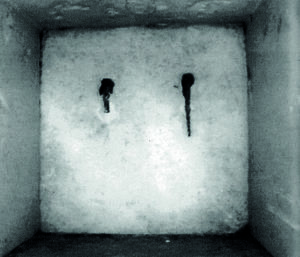
Fig. 7.39 – The locking stone encountered by Gantenbrinks‘ video robot in the south shaft of the „Queen‘s“ Chamber. The left copper handle is broken off, probably by the investigations of Morton Edgar, when he pushed a rod construction up to this stone in 1929. In the north shaft both copper parts are still intact.
1994 – Passageway into the Sphinx
On 10.10.1994 a report appeared in the „Hamburger Abendblatt“ that workers had discovered a passage on the left side of the Sphinx during the restoration that led into it. For me, this was another confirmation of the discovery documented in 1978 (see page 202).
Note: Dr. Mark Lehner later said that passages and cavities had already been known under the Sphinx before 1994. A 1995 NBC documentary says that there are 9 cavities, almost all of which are filled with water.
1994 – Alignment of the pyramids to Orion constellation by Bauval and Gilbert
This important discovery by Robert Bauval and Adrian Gilbert that the pyramids and the Sphinx were aligned exactly to the Orion‘s Belt stars and the constellation Leo around 10500 B.C. is described and documented in the Outlook (see page 301). This brings us back to the time of the late Altantis period.
1996 – Secret “Daedalos Project” in the “Queen’s” Chamber by the Supreme Council of Antiquities and Private
Here it continues in the shaft or at the stone door, which Gantenbrink discovered in the “Queen’s” Chamber in 1993.
However, I could only find this discovery in Erdogan Ercivan’s book “Forbidden Egyptology”. Nothing was published publicly and I could not verify these discoveries through any other sources. However, it seems credible. He passes on the testimony of a Yamal who worked for the Supreme Council of Antiquities. He says that the blocking stone was opened in autumn 1996 with a robot specially developed for this project, which bore the name Daedalos. Not only in 2012 in the TV show “Night of the Pyramids” (see page 227). The shaft should not end in a chamber, but should lead into the pyramid body at an angle of 90° in T-shape. In the course of the Daedalos Project, the Egyptian workers had found another chamber next to the “Queen’s” Chamber. It is 5 m long, 4 m high and 2 m wide. There are two connections in this chamber. One through the “Ventilation” Shaft with the blocking stone and one behind the granite slab in front of the “King’s” Chamber.
Note: Probably one of the 2 chambers discovered by Dormion (see page 226).
1996–1998 – Schor Expeditions and the “Osiris“ Complex
The multimillionaire, Dr. Joseph Schor, received an exploration license from the Supreme Council of Antiquities (SCA, previously the EAO) in May 1996. Schor, who had grown rich in the food and vitamin industry, wanted to find the Hall of Records mentioned by Edgar Cayce and thereby proof of the existence of Atlantis (see page 179). He is a “Life Member” of the A.R.E. (Association for Research and Enlightenment), which was founded in 1931 by Edgar Cayce, to evaluate and research the information that Cayce received while in a trance.
However, the official explanation for the justification for the work to be done and the issuing of the offical licenses read: “Research of the substrate for geological faults and cavities that could potentially represent a danger to tourists or the monument.“
Schor, however, later made no secret of the fact that the goals were far different than those officially stated. He traveled to Egypt himself to coordinate the explorations and to maintain contacts. Schor made available ultra-modern remote sensing equipment worth well over a million dollars.
His team included Thomas L. Dobecki and the filmmaker, Boris Said, who had previously also been part of the John A. West team (see page 59). They were also accompanied by four geologists from Florida State University.
One of the many goals of this research was the third level of the “Water Shaft” beneath the “Chephren” Causeway, which today is mostly called “Osiris Tomb” and by me “Osiris” Complex, and which had been discovered in 1935 by Dr. Selim Hassan (see documentations and photos to the “Osiris” Complex, p. 90 ff.).
The remote sensing specialist, Dr. J.J. Hurtak, was also called in to assist the team, from whom Schoch also expected additional scientific findings. Because of his paraphysical abilities Hurtak was able to state the exact location of the “Osiris Tomb” under Giza even before the Schor expedition set off for Egypt.
In February 1997, Boris Said and James Hurtak descended to the third level, which had been emptied of water only shortly before after probably having been water-filled for millennia. The room was still covered with sediments and deposits. Said and Hurtak discovered a granite surface in the middle of the room, just a few centimeters / inches beneath the sediment.
Using a ground penetrating radar device, Hurtak examined the subsurface and found a granite slab that was around 0.75 m / 2.7 ft thick. 2.5 m / 8.2 ft lower, he located an anomaly, which appeared to be half-spherical ceiling, around 2.5 m / 8.2 ft wide. This anomaly continued descending at a 25 degree angle and disappeared in the direction of the Sphinx (we will return to further passages in the Notes).
Said and Hurtak reported their findings to the Chief Inspector of Giza, Zahi Hawass. Because their client, Joseph Schor, only had permission to carry out radar measurements and filming, they were not permitted to conduct any excavations.
Hawass started the digs himself the following year 1998.
The crowning glory of the Schor expeditions was the broadcast of the television program: “Opening the Lost Tombs: Live from Egypt”, which was shown on Fox TV on March 2, 1999, and in which Zahi Hawass played a main role, designated as the discoverer of the underground complex beneath the “Chephren” Causeway; he purportedly uncovered the second level and discovered the two sarcophagi. This contradicts the established fact that this room was discovered and entered by Selim Hassan in 1935 (see page 179). The program placed particular emphasis on the third level, which Hawass presented as the “Osiris Tomb” and which had been discovered by Dr. J.J. Hurtak.
Notes to the unexplored passageways:
Already in 1996, about 10 months before the beginning of his first of the four expeditions, Schor had discovered a passageway heading west behind the Sphinx.
He determined that if this passageway continued on straight ahead, it would lead to the third level of the “Osiris” Complex and then on to the “Chephren” Pyramid.
In 1997, Hurtak located a cavity and a passageway in the lowest chamber under the sarcophagus.
Afterwards, another unexplored passage was discovered on the north side during the excavations of Hawass in 1998, pointing towards the “Cheops” Pyramid. However, it narrowed after about 6 m / 19. 82 ft and was impassable. We remember the interview with Andrew Bayuk in 2000 (see page 90), which Dr. Zahi Hawass published on his website. There he spoke of plans to lead an optical probe through, but the public did not know what came out of it. And without further exploration of the tunnel, the Chief Egyptologist already wanted to know at that time that the passage did not lead to the Great Pyramid.
According to a documentary by German television ZDF in 2005 based on Egyptian principles, the corridor now stretched 9 m / 29.63 ft until it became impassable for a crawling person. It was suspected that the passage could lead to the Sphinx.
In a video by the Swiss artist Gregor Spörri from 2009/2010 (see also “Well Shaft”, page 189), he surprisingly concludes that the tunnel at the north end leads 20 m deep into a small vault. From there two more tunnels went on and he suspects, one into the “Well” Chamber under the Great Pyramid and the other into the secret chamber under the Sphinx.
In 2011, I was down there for the second time and could enter the passage, but again only about 9-10 m. I saw neither a vault nor any further passages. In 2017, the rotten wooden construction had collapsed, leading across the water to the passage in the corner. So I could not check whether it was continued.
Another article on these courses appeared in Matrix Magazine (Volume 96, December 2016) by the German, Gernot Geise, entitled “The beard of the Sphinx… and the search for interior spaces”. There he reports (but without reference):
“Underground radar images of Dr. Boris Said’s deep topography show a tunnel leading from the back of the Sphinx back part to a room in the middle of the path of the Chephren Pyramid. From there the passage continues and ends at the pyramid.
This so-called “Blind Corridor” is also called the “Black Chamber”.
The “Green Chamber” or “Osiris Chamber” is to be located directly 18.83 meters below. The “Osiris Chamber”, which is completely filled with water, is to lie forty meters below the Sphinx, is 18.46 meters long, 15.78 meters high and 5.43 meters wide. In the western section above the ceiling there is a 3 x 6 arcuate field. The arch is supported by five protodoric columns and is sculpted with six Djed pillars. On the remaining area of 52 square meters there should be another six columns, in the middle of the columns a round arch made of stone.
Four connecting shafts would lead to this chamber:
1) The “Blind Corridor” at the Sphinx back, which originally formed a dead end after about eight meters, but which has since been broken open,
2. the “Chimney” or “Air Shaft” south of the Sphinx body,
3. the “Red” or “Small Chamber” directly five meters below the forefeet (which was discovered in 1993 by Dr. Dobecki), which was lined with red granite and contained four columns. From its interior, a horizontal corridor leads to the east and a vertical corridor to the south (to the “Osiris Chamber”).
4. The “Tunnel Corridor” connects the “Osiris Chamber” with the three levels of the “Osiris Shaft”. It divides into Y-shaped sections after about two hundred meters and leads under one of the big pyramids.
The entire plant is filled with water. So far, only the “Red Chamber” has been able to be drained.”
Notes on the Giza complex as whole:
The Schor team carried out their research four more times from 1996 until the end of 1998. With help from their cutting-edge equipment, among the things they discovered was the existence of a tunnel that lies around 12 m / 39.4 ft below the Sphinx, as well as another one on the eastern side of the “Cheops” Pyramid. These measurements also confirmed the anomalies that the Schoch-West team found back in 1991 below the forepaws of the Sphinx, which indicated the existence of a rectangular chamber.
In autumn 1998, Joseph Schor had a conversation with the author, Robert Bauval, who reported it on his website: “his radar survey around the Sphinx virtually confirms the existence of an underground network of tunnels and chambers. Dr. Schor – although friendly and extremely welcoming – was very limited in what he could allow me to reveal to the general public. (…) Because, as Dr. Schor explained, he was under contractual obligation from the SCA not to make his findings public without their official permission.”
The SCA was the Egyptian authority that had granted Schor his license, the official goal of which was the “exploration of underground geological faults and cavities … possibly injurious to tourists and the ancient monuments.“ The question is: Why was this research kept ecret?
1996 – Discovery of passage from „Relieving“ Chambers into „Queen‘s“ Chamber by Dr. Zahi Hawass
A long-time confidant from Giza told me that two members of the Hoagland team paid $50,000 in 1995 to prove that Dr. Hawass had conducted secret investigations in the Great Pyramid and discovered a new passage.
After that, they apparently informed Sabri Abdelasis. Back then, he was the head of Hawass in the Supreme Coucil of Antiquities. Hawass was in the USA at that time and was confronted with it after his return in 1996. In the following days, Zahi Hawass had this passage from the „Relieving“ Chambers to the „Queen‘s“ Chamber brick up again.
Note: Access to the „Relieving“ Chambers and painting on the cartridges would have already been possible in the Pharonic period (see page 185).
1997 – Secret excavation in Great Pyramid proved by Hoagland
The reason could be connected with what the former NASA employee, Richard Hoagland, reported on the Internet in 1997 at www.v-j-enterprises.com/tunnel.html. Hoagland, who reaches a wide public for his delving behind the scenes on a variety of topics, was approached by a man from the Schor team, who sought a way to inform the public without revealing his identity. He reported that parallel to the official research being conducted, that other work was being carried out in the “Cheops” Pyramid. In November 1996, work began in a tunnel above the “King’s” Chamber. Three months later, in February 1997, a new power cable was introduced to the area of the “Relieving” Chambers, extending upward from the Great Gallery. The informant suspected that the clandestine action was aimed at reaching the room on the other side of the “Gantenbrink” door, which was referred to as the Isis Chamber in the report.
Hoagland had the informant’s statement corroborated by the independent Egyptian researcher, Larry Hunter, who traveled to Giza and subsequently confirmed all that had been said with photos. Hunter also gave his photos, which included the thick electrical cable, the first “Relieving” Chamber full of dust and jute bags filled with stone fragments, to the Egyptian newspaper, “El Waft“ (The People).
Hoagland’s report was largely consistent with what my confidant told me.
There was increasing and clear public criticism of the secret activities in Giza, but without any effect. Chief Inspector, Zahi Hawass, later sarcastically commented upon the “Giza conspiracy”. The article entitled, “Dig Days: The Giza Conspiracy“, which can be read on the internet at: http://guardians.net/hawass/the_giza_conspiracy.htm, begins with the lines:
“If you check the Internet, you will see many strange things written about the Giza pyramids. The authors, mostly American and European, are under the impression that we are secretly digging inside the pyramid of Khufu. They believe we are hiding things that will reveal the existence of a lost civilization, and that we have discovered tunnels leading from the pyramids. A few years ago, we closed the Great Pyramid for conservation and restoration. We decided to clean the five relieving chambers that top the king‘s chamber, and to do this we removed stone rubble from the Great Gallery. On the Internet I found many stories about our involvement in a conspiracy, suggesting we were digging inside the pyramid without telling anyone.”
Curiously, no existing description of the relieving chambers ever mentioned that rubble was scattered about.
Nevertheless, the “Cheops” Pyramid was closed for months at a time on several occasions in the years 1996 to 1997, purportedly for the cleaning of the “Relieving” Chambers?
Excavations are more likely, because this is usually how the stony debris is created.
According to the trance statements of Edgar Cayce, important discoveries were to have been expected in Giza in this time period. Perhaps these prophecies and the approaching year 2000 caused the Giza authorities to choose to search for the Hall of Records in secret, particularly in view of Cayce‘s further prophesy that it would take many years after their initial discovery that the news would reach the general public.
For Zahi Hawass, however, the Cayce people are “pyramid idiots“. On the Internet he wrote: “Some people have written non-scientific books about the Pyramid of Khufu, claiming that the pyramid was built by a lost civilization, known as Atlantis. […] The ‘Pyramidiots,’ as I like to call these people […].“
And in his tirades against the “charlatans” Schoch and West, he accused them of promoting the Cayce theories.
His strong opinions did not, however, prevent him from working closely within the Cayce circles on various occasions in the 1990s, and he appeared as a speaker with Joseph Schor at the Egypt Conference in August 1998 held by the A.R.E. in the Cayce stronghold of Virginia Beach, USA.
There, Schor publicly stated that this research had located “a chamber or a natural cavity at a depth of 25 to 40 feet” as well as another subterranean chamber near the Great Pyramid and also unusual formations within the pyramid itself. Hawass confirmed the existence of the hollow spaces described by Schor and announced that he would look beyond the door in the southern shaft of the “Queen’s” Chamber within 1998. He also mentioned the activities above the “King’s” Chamber. According to his statement, “the second relieving chamber was cleared of dirt and loose stones” and further: “It does not mean that for every job I do, I have to hold a press conference.” (Atlantis Rising Online, Issue 13 “A.R.E. CONFERENCE HIGHLIGHTS GIZA CONTROVERSIES”, at www.atlantisrising.com)
“Cheops” Pyramid: “Relieving” Chambers – Where did so much rubble come from?
1998-1999 – Further secret excavations and new chamber in the Great Pyramid by SCA
In 1998 and 1999 intensive research was carried out in the Great Pyramid. On the one hand secret, on the other hand also official, as we will see in the two following reports on the investigations of Prof. Kerisel and Dr. Berner.
However, I have to write that it is not verifiable because there are no official publications on it.
The following excerpts from the secret excavations are from the book “Verbotene Ägyptologie” (Forbidden Egyptology) by the controversial author Erdogan Ercivan, to whom I accuse good intentions:
p. 308: “From February 1998 to July 1999, the responsible authorities of the Egyptian Antiquity Administration had closed the Great Pyramid of Giza and made it inaccessible to all visitors. It is said that restoration work was carried out there, which would remove the salt deposits caused by moisture and the evaporation of the masses of people. Furthermore, about 300 cracks in the rock of the Great Gallery were to be secured and a new ventilation system and lighting system based on French technologies were to be put into operation afterwards. In fact, however, new, previously unknown chambers were discovered and everything was done by the authorities to subsequently cover up these discoveries. Even Dr. Zahi Hawass confirmed these discoveries and said during the restoration work in September 1998: “The Queen’s Chamber and an’additional room’ will also be repaired and then opened to the public. […]
P. 309: In my 1997 investigations, however, I was able to visit a chamber-like room on the north side above the Great Gallery, whose existence is not mentioned in the specialist literature. […]
p. 317 ff: Before the Egyptian authorities released the pyramid of Cheops in July 1999 for a limited number of tourists, mysterious work was done there. […]
Until mid-March 1998, there was a huge white tarpaulin covering the pyramid on the west side of the building. Allegedly, cracks had been repaired there that resulted from the blasting work at Vyse. Then why was photography absolutely forbidden in the pyramid environment? Moreover, the west side is not the one where the Vyse team blown a hole into the pyramid in 1837 to find a possible entrance, but the south side! As far as I know, NASA was involved in the research in addition to the SRI staff. The team also included a Japanese delegation from Waseda University and archaeologists and technicians from the French Academy.
Germany was also present through representatives of the University of Saarbrücken, who had been entrusted with work on the pyramid and sphinx. During the work in the pyramid, several tons of rubble had been removed from the structure, which was transported in several truckloads of 3,500 kilograms.
In addition, the Egyptian scientists brought two hydraulic pumps into the pyramid, the purpose of which was not explained further.”
1998 – New chambers in the pyramid and 200 cavities by Dr. Berner
This excerpt also comes from the book “Verbotene Ägyptologie” (Forbidden Egyptology) by Ercivan. However, the report or the author cannot be clearly identified. Ercivan wrote:
“In March 1999 I received a revolutionary article from a reader, which had been published in the tabloid press under the title “The 6 Secrets of the Cheops Pyramid”.
However, my research revealed that neither the responsible reporter nor the alleged archaeologist could be found in the German-speaking area. After countless conversations with the editorial staff, Mrs Zerfass finally informed me that the article had been taken from an American magazine and that the archaeologist responsible, who reported on the pyramid of Cheops, already used a pseudonym in the original American story, but the reporter actually worked there”.
The report says, among other things:
“Dr. Helmut Berner, archaeologist at the University of Saarbrücken, was able to carry out seismographic investigations with sensors and infrared devices together with three colleagues in the Cheops pyramid in April 1998. He was able to locate over two hundred artificially created cavities. In August 1998 he repeated the investigations with specially designed X-ray equipment, whereby the cavities could be confirmed. A similar number of cavities were found by Prof. Sakuji Yoshimura of Waseda University in 1987. Dr. Berner describes the use of a video robot that functions similarly to Gantenbrink’s “Uponaut”, but the results seem quite fantastic:
“We sent a remote-controlled mini robot with integrated video camera through a shaft that barely has the diameter of a stovepipe and leads vertically into the height. After a trip of 150 meters, he slid into a chamber on his caterpillars. There we filmed mountains of parchment rolls with unknown characters […] We hoped that the robot with its grippers could transport the documents outside. But then something unbelievable happened: His heat sensors suddenly measured a heat of over 1000 degrees. “We had to watch on the monitor as the robot melted together into a glowing lump of metal.”
The company described was the “Daedalos Project”, which began in 1996 with the “ventilation shafts” and was intended to investigate completely new areas of the pyramid. Unfortunately, no details were given as to where this ominous shaft is located. Has the hidden chamber of Kinnaman & Petrie been rediscovered here?”
Note: This raises several questions. The mentioned 150 m / 452,15 ft; because the Great Pyramid itself is almost 147 m / 482.34 ft high. Except the shaft would be covered start at the “Cisten” Chamber and go almost to the top, where the Chamber of Knowledge should be located. Then the “heat of over 1,000 degrees”, for how could they have been created and measured by Berner? In addition, the parchment rolls would have first gone up in flames and then the control systems and the video camera would have failed. Then, how could they have seen the robot melt?
And it goes even further, because according to Ercivan Berner reports on accesses that are to lead to another, previously unknown chamber that was investigated:
“A few days ago, three of our researchers discovered a mural in a pyramidal corridor with a strangely sparkling eye sticking out of it. When the men touched it, a wall suddenly opened. Behind it was a staircase that led steeply into the depths. The explorers walked down the 123 steps and finally reached a door made of pure gold! We have not yet succeeded in opening this door.”
Note: More precise information is also here missing as to which pyramid course he is talking about. The description also recalls the discoveries of Lewis in 1976, who also reported secret entrances and a staircase with many steps (see page 193).
1998–1999 – New corridors around the “Cistern” Chamber by Prof. Kerisel
Prof. Jean Lehuérou Kerisel, an engineer in geotechnics, who also wrote the books “La Pyramide a Travers Les Ages”, “Génie et démesure d’un pharaon” and “Le Nil: l’espoir et la colère. De la sagesse à la démesure” (The Nile and its Masters: Past, Present and Future). He began his work in 1990 in the Great Pyramid, especially at the “Ventilation” Shafts in the “King’s” Chamber. In 1991 he was involved in the discovery of underground corridors and rooms for the extension of the Cairo subway and in 1992 he discovered an unknown corridor in the Great Pyramid (see page 223).
Ercivan reports and other about these discoveries in 1998 by Kerisel:
“French civil engineer Professor Jean Kerisel was able to prove another anomaly below the construction site, apart from the 300-metre-long underpass between the sphinx and the pyramid:
“Under the floor of the descending corridor, we discovered a building,
which may be a south-east-north-northwest oriented passage whose ceiling is at the depth that the descending passage would have reached if it had been extended.” But that’s not all!
“On the west side of the descending corridor, about six meters from the entrance to the unfinished chamber, another vertical shaft with a cross-section of 1,20 x 1,40 meters leads at least five meters down at an angle of 30°”. Before the Egyptian authorities released the pyramid for a limited number of tourists in July 1999, work was again undercover there. […]”
2000 – Discovery of further chambers in the “Cheops” Pyramid by Dormion
The French architect, Gilles Dormion (see page 189), returned to Egypt in the year 2000 to make carry out further remote sensing surveys. This time he was accompanied by the real estate magnate, Jeans-Yves Verd’hurt, who also financed the expedition. In the Pyramid at Meidum, he discovered two “Relieving” Chambers above a passageway, which led to the alleged tomb chamber, which earned them a certain degree of respect in Egyptology circles. The French team carried out a survey in the “Cheops” Pyramid in April 2000, which again indicated the existence of hidden chambers, one in particular beneath the “Queen’s” Chamber, not directly beneath it, but somewhat to the west. This places it on an intersecting line with the diagonals, more or less in the “heart” of the pyramid.
Both researchers were of the opinion that this chamber is “in all likelihood Cheops’ tomb”. They do not believe that the “King’s” Chamber was the final resting place of the Pharaoh; possibly because it was not secure enough because several granite beams in the ceiling were severely cracked. This view would indicate that the cracks were already present at the time of the pyramid’s construction. It is astonishing that the ceiling has held up to the present day. However, these cracks could also have occurred much later, such as during the big earthquake of 1301.
Dormion and Verd’hurt applied to Giza Chief Inspector Zahi Hawass for permission to carry out experimental drilling. Media reports stated that Hawass confirmed that such a request had been made: “They did work last year inside the pyramid. They used radar … and they said that the radar shows that there are rooms and tunnels inside Khufu…” Hawass also stated: “We cannot drill in the pyramids based on hypothesis. But we will give them a chance.” (Discovery: “Frenchmen plan to drill into Great Pyramid”, www.iol.co.za). Despite Hawass’ seeming assurances, the Frenchmen were not granted permission to continue their research. In September 2004, they published a book entitled: “La chamber de Chéops. Analyse architecturale” (The Chamber of Cheops – An Architectural Analysis).
2002 – 2nd exploration of “Ventilation” Shafts
(Live TV broadcast “The Night of the Pyramids”)
Nearly ten years after the two important discoveries made by Rudolf Gantenbrink (see page 193): first, that the shaft on the southern side of the “Queen’s” Chamber of the “Cheops” Pyramid is much longer than previously assumed, and second, that after 65 m / 213.3 ft, the shaft is blocked with stone slab door, the next official step was taken and with a media spectacle, the world got to see beyond the door on television. The (alleged) live television broadcast was around the world by National Geographic and was reportedly seen by half a billion viewers. Only the official masters of Giza were shown or heard from in the program; Rudolf Gantenbrink was excluded entirely and a new robot, “Rover 2.0”, was used (14 x 30 cm / 5.5 x 11.8 in), which was built by a high-tech company in Boston.
The author Robert Bauval (see page 209) commented on this circumstance:
“I have discovered that TV6 is the official production company (London based) that is making “Secret Chambers Revealed” for National Geographic, to be transmitted live from Egypt on the 16-17 September to Fox in the USA, who in turn will broadcast live in the USA. […] it was unclear how they [the Giza leaders] can explain the 9 years delay, and may pin the blame on Gantenbrink and the typical bogeyman scapegoat that he allegedly leaked the news of the discovery to me in April 1993, and I blew the whistle with the British media. We all know the truth about this, […] that Hawass simply used this as an excuse to elbow Gantenbrink out of this project, and hold on to it for 9 years till he was promoted to Chairman of the Antiquities and be in full control of the opening of the door and reap the full attention for himself. This is an archaeological scandal that the world needs to be reminded of, and condemn”.
(Quoted from a newsletter from the journalist, Giorgio Tsoukalos, who sent it over the Internet in August 2002, in protest to the exclusion of Rudolf Gantenbrink from the shaft television program.)
The TV event was planned as a neat piece of propaganda from the very beginning, as one is accustomed to reading in reports on Zahi Hawass’ website. In his article, “The Secret Doors inside the Great Pyramid“, the Chief Inspector wrote:
“One of the main goals of the documentary was to show the public the evidence of the people who built the pyramids. I was to talk about tombs, show graffiti which names the work gangs that built the pyramids, and even go inside of the Stepped Pyramid of Djoser for the first time. […] One day before the show, we found out by altrosonic that the door in the southern shaft of the Great Pyramid is about six centimeters / 2.4 inches thick, which implied that there was something behind that door. We decided to drill a three-millimeter / 0.1 inch diameter hole in the door so we could send a camera behind it. In the last minutes of the show, the camera was sent in, and we saw the second door 21 cm / 8.3 inches. behind the first door.”
The primary aim of the television program was to solidify the world view of official Egyptology. It was constantly emphasized that the Giza Pyramids were built by the Pharaohs and that this was proven fact. Mark Lehner played the central role in driving this point home. Also shown, purportedly for the first time in front of live cameras, was how Hawass and an archeologist opened a tomb. They did so in a fully unprofessional manner with a crowbar. Neither of the two explorers wore masks, although it is known today that grave robbers of yesteryear did not die of the curse of the Pharaohs, but from microorganisms. There was a skeleton in the stone coffin, “probably of a foreman from the pyramid construction“, which Dr. Hawass determined with an educated eye based on the sarcophagus and the inscription on the door frame.
Shown “live” the end of the program was how the robot lifted the final part of the shaft, which was only 20 cm / 7.87 in wide, at an angle of 39°, and came to a halt in front of the block (around 16.5 m in front of the outside of the pyramid). It is also equipped to put pressure on the stone and try to set it in motion. The attempt was also made to operate the two copper holders, but without success.
Then the robot bored a hole through the miniature door, which is 8.5 cm / 3.34 in thick, and then pushed a mini-camera through. The world was then shown that behind the slab was only a short, empty room, which ended with a wall full of cracks. Some experts see this wall as a second door.
This “revelation” occurred in the last five minutes of the program, which lasted for several hours, which could easily indicate that the whole thing was staged. What would they have done if a sensation had been discovered behind the sealing slab?
For an authentic live broadcast, it would make more sense for the “act of discovery” to be placed in the first half of the program in order to discuss the result and anything found afterwards. However, the only two messages presented by the greatest media event in history in terms of Egyptology were: in Giza and the “Cheops” Pyramid there is nothing more to be discovered and the Pyramids were built by the Pharaohs.
Not a word was spoken about the “Ventilation” Shafts, which I call “Star” Shafts (see page 214), neither about the Giza Wall, much of which had already been erected at the time of the broadcast. If the Wall project was not meant to be kept a secret, then this worldwide television program would have offered the ideal platform to explain the meaning and purpose of the 6 m / 19.7 ft tall fence around the Giza District.
In his article, “The Secret Doors inside the Great Pyramid,” Zahi Hawass provided the following explanation for the Giza research in the recent years regarding the closing of the pyramids:
“Serious scientific work on the Great Pyramid began in 1993, when we closed the pyramid for the first time for a full year. It was part of a plan to institute a rotational system at Giza, closing one pyramid for a year while leaving the other two open, in order to balance conservation with tourism.”
Among the reasons he gave was the high humidity inside the pyramid caused by the visitors‘ breathing, which has led to the formation of a layer of salt on the walls of the “Cheops” Pyramid. The
Great Gallery was cleaned for this reason in 1993. In this connection they also came up with the idea to install a ventilation system in the “King‘s” Chamber, which in turn led to the discovery of the door in the southern shaft of the “Queen‘s” Chamber. In answer to why it took nearly ten years until (officially) they first took a look behind the door, Hawass stated:
“I believed there was nothing behind this door at all but that it was very important for scholars and the public alike to know that there is nothing behind it. […] Before the show, I went to Hong Kong and Singapore to publicize it, and Mark Lehner went to Australia, India, and Spain right after the show. I, as well as my colleagues at National Geographic, wanted to be sure that we were honest and people were prepared for whatever find (or lack thereof) that we might make.”
It is somewhat unclear what exactly is meant by this final sentence. “I, as well as my colleagues at National Geographic, wanted to be sure that we were honest and people were prepared for whatever find (or lack thereof) that we might make.” What does he mean when he says that he and his colleagues “were honest“? Could he have meant that he could be relied upon to be able to keep secrets, because there were circumstances and findings associated with the program and research in Giza that were not meant for the public?
Zahi Hawass also stated:
“A few days after the show, we sent the robot into the northern shaft. Gantenbrink and Dixon both were only able to probe 8.2 m / 27 feet because of a twist in the shaft. After further investigation, it seems that the turn was made in order to avoid intersecting the Great Gallery, implying that the shafts were cut after the Great Gallery’s construction.”
Notes: Other sources have reported that the robot also came upon a door with copper handles after 62 m / 203.4 ft. Both shafts leading from the “Queen’s” Chamber measure 20 x 22 cm / 7.9 x 8.7 in. How could they have been “chiseled out“ for a distance of over 60 m / 196.6 ft, after the pyramid was built? The discrepancies are apparent. They are determined to prove, by hook or by crook, that the Great Pyramid is part of an ingenious total plan and more than mere patchwork constructions of experimenting 4th Dynasty builders, as is insisted in the official Egyptology history books.
Nevertheless, Hawass did indirectly admit in the same article that there could perhaps be even more chambers to be found in the “Cheops” Pyramid, and thus fuelled speculation about a previously undeclared “Cheops” burial chamber:
“The presence of these doors in the Great Pyramid creates many questions. One idea is that the doors are a challenge that the king must face before his travel into the afterlife. […] Also, why do they not exist in the shafts of the third chamber? Logically, they should be where the king’s body is buried. It is possible that these doors are evidence that Khufu’s burial chamber might be hidden somewhere inside of his pyramid.“
About the pictures:
In 1993, the world first saw pictures from one of the two „Ventilation“ Shafts in the „Queen‘s“ Chamber, especially the closing stone at the end of the shaft. The two copper handles, of which the left one was broken off, were conspicuous. The big question was: What is behind this stone? First it was said that an official research would take place in 1996, then in 1998. However, it was to be September 2002, until the public again came to know something about it.
With a worldwide TV-spectacle a „Night of the Pyramids“ was organized, during which the drilling of the stone closure and the first view behind the stone were to be broadcast „live“. These pictures were shown as well, but only in the last minutes of the transmission.
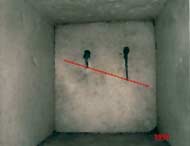
Cheops “Ventilation” Shafts – This is what the „handles“ looked like in 1993.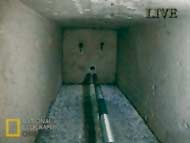
Cheops “Ventilation” Shafts – A picture of the alleged live transmission from the shaft. Both copper handles are broken off! The broken piece does not lie in front of the closing stone, which means that it was taken out of the narrow and steep shaft which is 65 m / 213.2 ft long. Between 1993 and 2002 further unofficial attempts were made!
2004 – The “Pyramid War” between the Egyptologists
The 9th International Congress of Egyptologists held September 6 – 12, 2004, in Grenoble came to blows between the French team of Gilles Dormion / Yves Verd’hurt and the Chief Inspector of Giza, Zahi Hawass. This was the same French team that conducted the remote sensing research in the year 2000 in the “Cheops” Pyramid and found a hollow space beneath the “Queen‘s” Chamber (see page 197), but who then were granted no further permission to continue their research.
“Dr. Hawass treats Egypt as his private hunting ground,“ commented the French team to the press, as reported in the British newspaper, “The Independent“ in its issue on November 22, 2004, in article entitled, “Pyramid Wars“. To which Hawass retorted in his own media conference:
“They are speculators and amateurs! […] What would you say if I came along and asked to drill a hole in Notre Dame cathedral? I cannot grant any old request. I have 300 of them on my desk. The applications have to come from an institution and they have to be convincing. We Egyptians have to keep our dignity. I am the guardian of the pyramids. Egyptian blood was spilled in the building of the pyramids. I cannot allow amateurs to tamper with the blood of Egyptians.”
2006 – Chambers behind the Sphinx below the way to the Middle Pyramid
The Polish team around Lucyna Lobos, to which we will return in 2010, provided me with documentation on ground penetration radar investigations in 2006, although the clients were unclear, but part of it was in connection with the NRIAG-REPORT 2007, in which the geological department of the government was also involved.
In section 6A, which was one of the three sections scanned along the Sphinx Causeway – the stone path between the Sphinx and the Middle Pyramid – there were anomalies confirming underground spaces according to the report.
Note: These are not the two large shafts behind the sphinx or the “Osiris” Complex. The SCA did not publish anything about this either.
2006 – Meteorite remains on the pyramids discovered by Dr. Pawlikowski
Dr. Maciej Pawlikowski from the Institute of Geology and Mineral Deposits at the University of Krakow in Poland worked as a mineralogist at the Red Pyramid in Dahshur and the Pyramid in Abu Rawash. He also researched the rocks of the 3 Pyramids in Giza in 2006 and published his results in 2007 in “Patina on the Bedrocks and Monumental Buildings of the Giza Region, Egypt. Zalewski, F., and Pawlikowski, M.”.
He discovered previously unknown metal structures on the pyramids and localized small traces of craters on the north side of the Great Pyramid, caused by meteorites that fell on Giza in the early days. There were several sections that were still fragmented after the impact. The Polish scientists still wanted to determine the time when and in which epoch this impact had taken place, on the basis of samples of the now formed patina on the rock samples. But now, 12 years later, I could not find a publication.
Perhaps the chronicles of Pharaoh Ramses III give us a clue to this, which lived 1191-1159 B.C. It reports of a comet that descended in the north of Giza, turning large parts of Egypt and present-day Libya into a sandy desert.
2006 – Miles of charcoal drawings east of Giza by Pawlikowski
The discovery of the meteorite traces mentioned above was actually a side stage, because the scientists around Dr. Pawlikowski wanted to investigate above all the possible scraping drawings, which they had discovered east of Cairo. According to satellite images, these are two main curved lines several kilometers long, which are connected at some points. They think they see a human-drawn, giant scarab in it. And they assume that the carving would come from the time of the fall of the comet to soothe and worship the sun god after the catastrophe. Pawlikowski compares them to the mile-long giant figures of Nazca in Peru, which can only be seen from a bird’s eye view (see Volume III GAIA LEGACY).
2007 – Theory of the construction of the Great Pyramid through Houdin
There are many theories about the construction of the 3 megalithic pyramids. Officially, the ramp theories still apply, i.e. that millions of stone blocks were transported up either via one or several long ramps, or via ramps on all 4 sides, which led around the pyramids like a spiral staircase.
The French architect Jean-Pierre Houdin presented a new combined theory in 2007, according to which an external ramp was used for the construction of the pyramid only for the lowest 43 m, but the further 103 m through an internal spiral ramp. The tomb of Pharaoh Cheops was so largely built from the inside. He says that his theory of two-stage construction is better than any other, because it is the only one that works at all stages of construction. It would also explain why there are no remains of the outer ramp, because its material was used for further construction of the pyramid. The limestone blocks, which weigh an average of 2.5 tons, were transported upwards within the pyramid by 10 workers each via 21 passages, each rising by 7°. At the end of each passage, the pyramid was open to the outside in order to be able to rotate the blocks by 90° for the next passage.
Notes: The theory of the “inner spiral ramp” was already described by Edgar Cayce in the 1930s!
All theories – like Houdin – are always based on limestone blocks weighing an average of 2.5 tons. But no theory has an explanation how this could be solved with the much larger and heavier blocks and slabs from the red granite? It is about much larger blocks in the gallery, the “Queen’s” Chamber and the “King’s” Chamber, where, for example, each of the 9 massive ceiling tiles alone weighs around 40-50 tons.
There are also many supporters and opponents of Houdin’s construction theory, even among Egyptologists. I’ll use the two voices that are best known to me.
Prof. Erhart Graefe of the University of Münster said:
“There was simply not enough water on site to moisten the sleds on which the stones were supposedly pushed upwards.”
This is a very important argument in all theories with the “wooden sledges”.
For Graefe the Great Pyramid was built in steps, like the Middle and the Small and other former pyramids. And the stone blocks had been levered up piece by piece over smaller brick stairs.
Dr. Rainer Stadelmann, former director of the German Archaeological Institute in Cairo, said:
“Houdin’s theory is not only interesting, it is coherent and revolutionary.”
That means a lot, because he made the most famous combination model to date, with 16 small start ramps, followed by 8 additional intermediate ramps, the material of which was then used for a larger side ramp. In the upper third follows a flank ramp and on the last 20 m / 65.74 ft a zigzag ramp.
Digital image released by Dassault Systemes 01 April 2007 shows a large external ramp used to build the first 43m of the Kheops pyramid. A French architect, Jean-Pierre Houdin, is convinced to have discovered the mystery of the Kheops pyramid’s construction : the builders may have used an inside spiral ramp to build the upper section. With the help of sophisticated computer software developed by the French company Dassault Systemes, Houdin has been able to reconstruct a three-dimensional simulation of how the great limestone and granite blocks of the pyramid were put together stone by stone. AFP PHOTO DASSAULT SYSTEMES
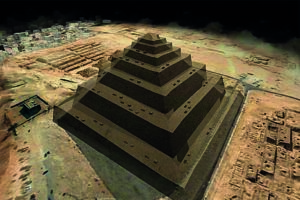
Digital image released by Dassault Systemes 01 April 2007 shows the spiral ramp within the structure’s outer wall of the Kheops pyramid to finish its construction. A French architecte, Jean-Pierre Houdin, is convinced to have discovered the mystery of the Kheops pyramid’s construction : the builders may have used an inside spiral ramp to build the upper section. With the help of sophisticated computer software developed by the French company Dassault Systemes, Houdin has been able to reconstruct a three-dimensional simulation of how the great limestone and granite blocks of the pyramid were put together stone by stone. AFP PHOTO DASSAULT SYSTEMES
2008 – Discovery of a cave system under the Giza Plateau by Collins
The Englishman Andrew Collins discovered these caves through old records of his compatriot Henry Salt.
Salt was British Consul General in Cairo in 1815 and a rich and passionate Egyptologist, who also commissioned the Italian Egyptologist Giovanni Battista Belzoni, for example, to direct the excavations for him. In his memoirs, Salt describes how he investigated in 1817, together with the other well-known Italian Egyptologist Giovanni Caviglia, a catacomb system which was several hundred metres long. They also found chambers and other cave passages in it.
Together with his wife Sue and the British Egyptologist Nigel Skinner-Simpson, Collins reconstructed Salt‘s expedition and used this as a basis for finding the entrance to these cave passages to the west of the pyramids. Today it lies close to a large administration building and, depending on the source, is called “Tunnel of Birds“, “Cave of Birds“, “Cave of Bats“ or archaeologically: “Cave NC2“. In March 2008, the three of them entered a complex cave system with corridors and chambers. Due to a lack of oxygen they had to break off and in April they penetrated deeper into the cave system with appropriate equipment and oxygen devices. The part they passed through is about 107 m / 351.05 ft long (see Fig. 7.57) and then a very narrow cave passage leads even deeper, through which one can only crawl on one‘s belly. They had to turn back because it was too dangerous. The research team found a very large room, which they call “Dome“. In addition there were animal bone remains and fragments of mummies. According to Collins, the caves are tens of thousands of years old, if not older, and may have inspired the construction of the pyramid complex and Egyptian ideas of the underworld. He continues to speculate that Giza is referred to in the old texts as “Rostau“, which means “the gullet to the corridors“ and for him this is a clear indication of an entrance to an underground world. He suspects that the cave corridor reaches under the Middle Pyramid and that the tomb of the mythical god Thoth could lie there, since it has not yet been found. In 2009 Andrew Collins published his book “Beneath the Pyramids: Egypt‘s Greate“.
Note: In 2008, Dr. Hawass told the „Discovery Channel“ that this cave system didn‘t exist and that they already knew everything about Giza. In 2009 he confirmed it, denying its importance and saying that it was only catacombs from the late epoch, of which there were many. Collins objected immediately, as they were natural caves and passages, hundreds of metres deep into the ground, possibly followed by a geological fold. The entrance was still open in 2008, but since 2009 it has been closed by a metal door. Later visitors report that even the last passage – which Collins had not passed and calls “Tube“ – has been bricked up since 2010.
When I was there in 2011, we first examined the entrance area, which is similar to other burial chambers from the dynastic times and was therefore built later. In the rearmost part of this complex, at a fracture in the ground, a staircase and an intermediate level lead about 10 m / 32.8 ft deeper into a collapsed chamber. From there a passage leads into the actually cave system in the direction of the Middle Pyramid. Then we unfortunately had to turn back immediately after entering the middle long cave passage, because our guard at the entrance warned us that a patrol was approaching.
I suppose the passage goes even further, deep under the Sphinx. It could also be part of the Lemurian complex, who probably built the first underground rooms. For them the raw cave passages to deeper chambers would be typical, which they closed again.
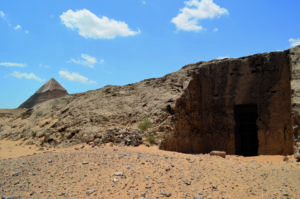
Tomb of the Birds – Entrance, on the left: the Middle Pyramid.
2008 – The pyramid as a water pumping station?
The theory of the pyramid as a water pump is almost 50 years old and is always discussed again.
It is based above all on the research of the Austrian Hermann Waldhauser, who copied a pyramid model on a scale of 1:100 and modified it with simple means to a functioning pump, which he even applied for a patent in 1976. In the same year he published his book “Regenzauber der Pharaonen: Die Pyramiden als Instrumente der Wetterbeeinflussung” (Rain Magic of the Pharaohs: The Pyramids as Instruments of Weather Influencing), in which he assumes, in addition to the water pump theory, that the Egyptians thus not only had a water reservoir for humans and the irrigation of fields in times of water shortage, but also used the pyramid to influence the weather or to produce rain.
In 1988, 20 years later, the American Christopher Dunn gained with his book, “The Giza Power Plant: Technologies of Ancient Egypt,” and the water theory new impetus. He went the extra mile to see how this hydroelectric power could be converted into electricity with plus and minus poles.
Another 20 years later, in 2008, the two Germans Stefan Erdmann and Jan van Helsing took up the topic again in their book “The Millennium Lie”.
In principle, the basic theses of Waldhauser and Dunn are used to argue that the pyramid is a water pumping station or reservoir. However, they also bring other aspects.
Erdmann wrote that he would focus on the following 4 questions on the water pump theory. I will give you my view and answers here:
1. Why did these pyramids originally stand in a walled water basin?
Because they were not water basins, since the enclosures are verifiably from a different construction period and phase and as water basins they would have been too small from the area and height of the walls.
2. Why are there water level lines in various chambers of the Great Pyramid?
Because they were flooded several times (according to Prof. Robert Schoch of the University of Boston in the times of the Floods and the Millennium Rain).
4. How does Nile mud get into the “Relieving” Chambers?
For the same reason, and meanwhile we know that there is a passage connecting the “Relieving” Chambers with the “Queen’s” Chamber (see discovery 1996 on page 221).
3. Why does the Great Pyramid have no entrance?
Because they – like the other two megalithic pyramids as well as the later dynastic pyramids – were covered at the end and therefore the entrance was not visible and accessible. In 2016, Dr. J.J. Hurtak told me during a conversation that he and his wife Dr. Desiree Hurtak found that my summary is largely correct. Also concerning the water question and that the complex was built in such a way that incoming water can drain off again. They could also imagine that the combination of water and solar energy was converted into hydrogen.
Notes: After all, I don’t share this theory that the pyramid was planned and built as a water pumping station, otherwise the other two pyramids would have been built in the same or a similar way. It was simply constructed in such an ingenious way that water which enters the pyramid can drain off again even after flooding. I also don’t believe that the pyramid can generate electricity, but from its Sacred Geometry it demonstrably produces electromagnetic fields (see also measurements by Alvarez 1968 on page 190), which also play an important role in quantum physics. However, this form of energy is not considered in the above-mentioned theories.
In my opinion, the Great Pyramid therefore serves more for the reception of such highly oscillating energies from the world space and spiritual worlds.
And of course as reference to the constellations of the stars and the way of initiation and ascent. In addition, the 3 pyramids and the Sphinx are also signposts to the complexes in the underground…
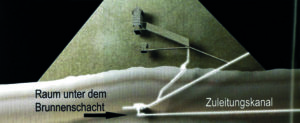
“Cheops” Pyramid- Representation according to Erdmann/van Helsing with an underground water inflow from the Nile.
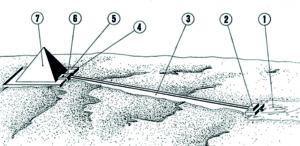 “Cheops” Pyramid – Representation according to Waldhauser.
“Cheops” Pyramid – Representation according to Waldhauser.
1. Navigable canal from the Nile, 2. Valley path/lock, 3. Access road/canal, 4. Main building/lock, 5. Enclosure wall, 6. Courtyard, 7. Pyramid superstructure. It also starts from the underground water inflow.
2009 – New boreholes for the Sphinx by Hawass and Lehner
In a video on YouTube, Dr. Zahi Hawass and Dr. Mark Lehner report on their unexpected ground drilling around the Sphinx (youtube.com/watch?v=3qGzfZHWbZE&feature=fvwrel).
Officially, the investigations were carried out to determine whether the Sphinx was threatened by the rising groundwater level. Lehner supervised this work “on behalf of Hawass”. As we will soon see, it is still unclear today whether the Egyptian SCA or – in the background – the A.R.E. gave the order and paid for it.
In cooperation with the University of Cairo, 8 boreholes with a diameter of 10 cm / 3.93 in were drilled to a depth of up to 10 m / 32.8 ft. A drill was also made under the left paw, exactly at the place that Hugh Lynn Cayce wanted to investigate deeper in 1978.
But half of the video is about “exposing the New Age ideas”, that under the Sphinx paw there are corridors and a secret chamber. It is astonishing that Mark Lehner describes these as “New Age ideas”, although he started researching the Sphinx on behalf of the A.R.E. 40 years ago in 1978 (see page 199) and continued in 1980 (see page 207), which searched for these chambers exactly at this point on the basis of Edgar Cayce.
And Hawass says at the end of the video that they didn’t find anything…
The Edgar Cayce Foundation (ECF) and the Association of Research and Enlightenment (A.R.E.) have had several documented contacts with Zahi Hawass since 1974 in order to find the so-called “Hall of Records” according to the principles described by Edgar Cayce in 1932 (see page 179). For this purpose the A.R.E. or the leading members received several approvals via Hawass from the Egyptian Supreme Council of Antiquities (SCA) in the years 1977 to 1998.
Robert Bauval writes about this in his blog (http://myblog.robertbauval.co.uk):
“It has been reported to me that there was also a drilling contractor employed by the SCA in 2008–2009 to drill with a much bigger machine in the area of the Sphinx, but not too close, in order to pump out the water to bring down the underground water table. I was, in fact, at Giza in 2009 and indeed saw the big drilling machines of this local contractor. So was the drilling of Lehner and Hawass under the Sphinx another direct shot at finding the “Hall of Records”? Were the two men closing an old but yet unfulfilled “deal” they had with the ECF?”
In Edgar Cayce’s A.R.E. Membership Newsletter “Ancient Secrets”, Feb/March. 2009, edited by John Van Auken, the following announcement was made:
“I met with Dr. Zahi Hawass, Secretary General of the Egyptian Supreme Council of Antiquities, after he spoke for an hour to our A.R.E. group. He shared that Joe Jahoda, a longtime A.R.E. member, had convinced him to drill under the Sphinx for a chamber. Back in 1997, Jahoda and his partner, Joe Schor, in cooperation with Florida State University, conducted ground-penetrating radar around the Sphinx and found an open area in the bedrock beneath the Sphinx. This opening, possibly a chamber, is 30 feet down and is estimated to be 26 feet wide and 40 feet in length. The Cayce readings identify this chamber as an ante-chamber to the Hall of Records that is off the right front paw of the Sphinx. Jahoda asked if A.R.E. would purchase the special drill necessary to drill at an angle into the limestone bedrock. Kevin Todeschi, CEO of A.R.E., approved the purchase, and our donation “angel,” Don Dickinson, agreed to help A.R.E. with this purchase. Thus, the drill was purchased, crated, and shipped to Egypt. Zahi said that soon after the drill arrives, he’ll get his team together and begin the drilling. It’s exciting news! We are taking a major step toward finding one of Cayce’s three Atlantean record caches. Stay tuned for updates.”
Notes: Jahoda was already involved in the pyramid research of RSI/SRI in 1978 (see page 199) and then in the background in 1996/98 also in the expeditions of Dr. Schor, also a high A.R.E. member (see page 217).
The A.R.E. is even said to have made possible and financed Hawass’ doctoral thesis in the USA, as can be read in the biography of Hugh Lynn Cayce, “About my Father’s Business” (by A. Robert Smith, 1988, p. 250.):
”I got him a scholarship at the University of Pennsylvania in Egyptology, to get his PhD. I got the scholarship through an ARE person who happened to be on the Fulbright Scholarship Board. He [Hawass] had aided Mark [Lehner] to work at the Sphinx, and I am very appreciative […] “
“The purpose and/or objective to help Hawass with his higher education in the USA was: “for Hawass to advance within the [Egyptian] government to further his own career and open doors for Hugh Lynn [Cayce]s project, [and] he could do it best on the wing of higher education at an American Ivy League college. “
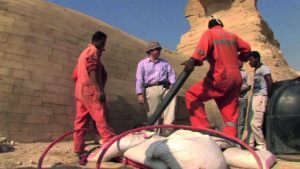
Sphinx – Drilling to 10 m / 32.97 ft below the famous left paw of the Sphinx in 2009. Hawass said they had not found any cavities.
2009 – Discoveries about the labyrinth in Hawara by Poles and Americans
The ancient Greeks Herodotus, Diodor, Strabon and Pliny already described this legendary labyrinth of Lake Moeris. It was then located near the ancient city of Arsinoe (Crocodilopolis) and all these ancient reports mention a multitude of temples and courtyards, unfortunately without specifying their number or location.
Herodotus, who traveled through Egypt in the 5th century B.C., mentions in his 2nd Book of Histories (Chap. 148) an enormous megalithic building which the priests there called the work of 12 Prehistoric Kings (https://bit.ly/2MSLvzk):
“Moreover, they decided to preserve the memory of their names by a common memorial, and so they made a labyrinth1 a little way beyond lake Moeris and near the place called the City of Crocodiles. I have seen it myself, and indeed words cannot describe it;
[2] if one were to collect the walls and evidence of other efforts of the Greeks, the sum would not amount to the labor and cost of this labyrinth. And yet the temple at Ephesus and the one on Samos are noteworthy.
[3] Though the pyramids beggar description and each one of them is a match for many great monuments built by Greeks, this maze surpasses even the pyramids.
[4] It has twelve roofed courts with doors facing each other: six face north and six south, in two continuous lines, all within one outer wall. There are also double sets of chambers, three thousand altogether, fifteen hundred above and the same number under ground.
[5] We ourselves viewed those that are above ground, and speak of what we have seen, but we learned through conversation about the underground chambers; the Egyptian caretakers would by no means show them, as they were, they said, the burial vaults of the kings who first built this labyrinth, and of the sacred crocodiles.
[6] Thus we can only speak from hearsay of the lower chambers; the upper we saw for ourselves, and they are creations greater than human. The exits of the chambers and the mazy passages hither and thither through the courts were an unending marvel to us as we passed from court to apartment and from apartment to colonnade, from colonnades again to more chambers and then into yet more courts.
[7] Over all this is a roof, made of stone like the walls, and the walls are covered with cut figures, and every court is set around with pillars of white stone very precisely fitted together. Near the corner where the labyrinth ends stands a pyramid two hundred and forty feet high, on which great figures are cut. A passage to this has been made underground.”
A further description of the courtyards and chambers of Herodotus reads:
“The flight of these crossways through the courtyards, the most colourful decoration everywhere – all this is full of innumerable beauty; from the courtyards one enters the chambers, from the chambers into the column halls, then again into chambers and again into courtyards. Everywhere the stone ceiling is as well as the walls, and these walls are full of reliefs, and every courtyard is surrounded by columns.[…]”
He says in other places that the numerous courtyards and porticoes that formed the forecourts of the individual sanctuaries confused the visitors who could not find their way in the repetitive room sequences and therefore described the complex as a labyrinth and that the temples and their courtyards corresponded exactly to the number of the 12 districts and kings of Egypt, which were arranged around a center and in which the local gods of the parts of the country were worshipped (see Fig. 7.64). According to Herodotus, these kings decided to unite their forces and create a monument for themselves.
Diodor and Strabon, who traveled Egypt in the 1st century B.C. – about 400 years after Herodotus – also visited this labyrinth and were deeply impressed. Strabon writes in the 17th volume of his work “Geographica”:
“It is remarkable, however, that the ceiling of each of the chambers consists of a stone and that the widths of the covered corridors are also covered with slabs of stone of extraordinary size, since nowhere wood or any other building material was used. If one climbs the roof, which is not at any significant height, one sees a stone surface of equally large slabs.”
The reports about the labyrinth show that these ancient historians and the Egyptians themselves already at that time all said that these megalithic constructions originated from the pre-dynastic time before the Pharaohs.
The possible location of the legendary labyrinth was already discovered in 1888 by Prof. Flinders Petrie. The above-ground labyrinth had been completely demolished, leaving only a large bed of stone fragments. In this heap of stone blocks, interesting objects were discovered, including foundations, massive granite shrines, a flower shape of pink granite, a large well, doorposts facing north and south, fragments of statues and a large granite figure of Amenemhat III, to whom the construction of the labyrinth is officially attributed. He ruled from 1842 to 1795 B.C. in the Middle Kingdom (12th Dynasty) and had 2 pyramids built. The first at Dahshur is also called “Black Pyramid” because the limestone sheathing is missing, and the second pyramid at Hawara. An enormous temple building formed the southern part of this large north-south oriented pyramid district of 158 x 385 m / 518.3 x 1,263.12 ft (= 300 x 735 cubits).
There were enough fragments left of the original foundations so that Petrie could determine the size and position of the structure and found that it roughly corresponded to the traditions.
In cooperation with the University of Warsaw, the medium Lucyna Lobos received in 2008 a permit for remote viewing of the pyramid and surroundings of Hawara in the Fayum Oasis, about 100 km / 328,084 ft from Giza. The main objective of the project in April 2009 was to locate the previously undiscovered entrance to the Pyramid of Amenemhat, also as a possible access to the underground labyrinth. The Polish team found 2 pyramid entrances within days, but – as so often – no permission was granted for excavation and opening. Dr. Hawass then had these entrances excavated by the SCA (When I was there in June 2012, I was able to enter both entrances and the interiors. The pyramid is clearly dynastic).
Then the Poles put the focus on the second goal, to find the labyrinth in the pyramid environment. However, after the quick and sensational discovery of a golden mask, Dr. Hawass’s investigation was stopped immediately, even before the search for the labyrinth or the access had begun at all.
However, the Polish team members told me that they had provided evidence for the existence of a large underground complex.
In 2010, the American Dr. Carmen Boulter provided further material for discussion with her video and the published underground animations. According to her, these are based on satellite scans of the Austrian Klaus Dona and an unnamed friend, from whose scans a 3D model was then made (see picture). But their technique is controversial, was rejected by Egyptology, and the representation of the chambers and corridors is not geometrically arranged – as in all traditions – but lie unevenly distributed almost crosswise to each other. However, they occupy underground complexes and research continues…
The German Joachim Gritsch von Enkira (who was involved in the Polish project) wrote that they found and received other information, which has not yet been scientifically tested:
• It is the largest building ever constructed by humans, with about 3,000 rooms, corridors, movable walls, etc.
• The construction lasted 365 years (from 4608 to 4243 B.C.).
• The diameter from east to west is 48,000 Egyptian cubits, 25.152 km.
• The astronomical knowledge of the Egyptians is written on the walls. All astronomical discoveries can be read from the hard to read writings. The constellations are accommodated on the huge zodiac.
• Many walls are movable. Hence the labyrinth. Ancient texts describe that people got lost there and then died there. They also tell of secret rooms inside the labyrinth, filled with art objects and documents of a civilization that blossomed there thousands of years before.
• Built after the “Golden Circle”, it possibly includes the “Halls of Records”. It is built of granite and a special technique with gold, which was transmitted from a vanished civilization much older than the Egyptian civilization.
• There are rooms with the documents of the history of Egypt and the astronomical knowledge of that time.
• On 36 magnificent panels is written with hieroglyphics, the kind of calculations of the last averting of the displacement of the poles of the earth.
This knowledge should be possessed by mankind.”
2009 – Finds through secret excavations with a tragic outcome
It has been known for decades that under the houses in the adjoining district Nazlet-el-Saman – close to the Sphinx and the Pyramids – was dug up again and again and some things had been discovered. Normally these illegal finds do not become public because they are sold on the black market.
In September 2009, during such secret excavations, first a house wall and then the whole house near the Giza wall collapsed. There were tragically 6 dead and it took 4 days to recover the bodies as they were buried in an 8 m / 26.2 ft deep shaft and a small burial chamber. There was talk of sensational finds, a sarcophagus and, depending on the source, 12-14 small golden figures, all from the dynastic period.
Since then, the local government and the SCA have been arguing about whether and how entire rows of houses should be torn down so that a strip of 40-70 m / 131.2-229.6 ft could be cleared, under which further chambers, installations and the road to the “Cheops” Causeway are suspected. We will come back to this in a moment.
This is an excerpt from the book GIZA LEGACY.


